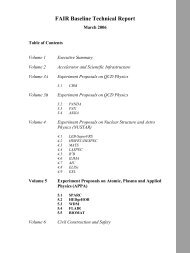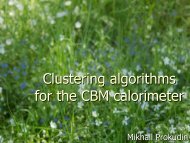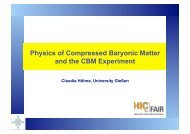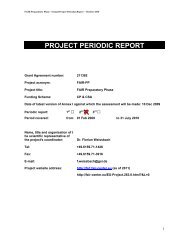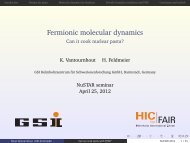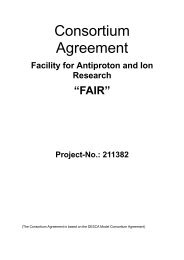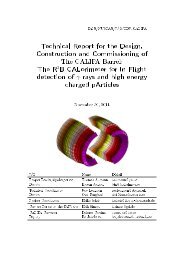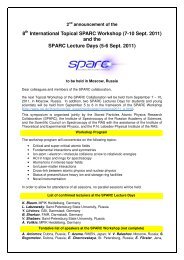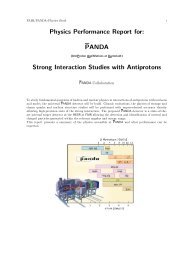NeuLAND - FAIR
NeuLAND - FAIR
NeuLAND - FAIR
Create successful ePaper yourself
Turn your PDF publications into a flip-book with our unique Google optimized e-Paper software.
8.1.2. Characterization of Neutron Interactions with the Full-Size<br />
Detector<br />
After the installation of the fully-equipped <strong>NeuLAND</strong>, again, a calibration experiment<br />
will be performed. The above-mentioned technique of quasi-free scattering of deuteron<br />
beams will be applied. Time resolution and efficiency of the full system will be determined,<br />
the latter as a function of neutron energy. Using the full detector volume, it<br />
allows in addition a detailed study of the event patterns for real one-neutron events.<br />
This is an important input for the development of tracking algorithms in order to optimize<br />
the recognition capabilities. The measured one-neutron response can be used in<br />
order to simulate the response of <strong>NeuLAND</strong> to multiple neutron events by overlaying<br />
several one-neutron hit-patterns, taken from experimental data. This method relies on<br />
the superposition principle for hit patterns on the <strong>NeuLAND</strong> detector.<br />
Moreover, <strong>NeuLAND</strong> will be exposed to real and clearly characterized two-neutron<br />
events, using the breakup of tritons as detailed in the following. Tritons provide a clean<br />
source of correlated two neutron events, where the intrinsic wave function is known with<br />
high precision. Quasifree proton knockout on the tritons with coincident detection of the<br />
two protons from the (p,2p) reaction enables us to put strict cuts on the reaction kinematics,<br />
in particular the transferred momentum to the removed proton. By requiring a<br />
momentum transfer considerable larger than the proton’s Fermi momentum inside the<br />
tritons we enhance events where the two neutrons act as spectators in the reaction, and<br />
thus keep their original correlations. Using the known n-n scattering length, also finalstate<br />
interaction can be taken into account precisely. The n-n relative-energy spectrum<br />
can thus be calculated reliably and compared to the observed spectrum. The response<br />
of the detector to 2n events is particularly important for low relative energy between the<br />
two neutrons, En−n, for which the efficiency drops rapidly. In addition, the incident CM<br />
angle of the two neutrons can be determined by the measurement of the angles of the<br />
two protons. This measurement will, thus, allow for a detailed check of the simulation<br />
procedure for the two neutron response.<br />
8.2. Cosmic Ray Tracking in <strong>NeuLAND</strong> for Adjustment and<br />
Calibration<br />
For the internal calibration of <strong>NeuLAND</strong> before, during and after experiments, tracks<br />
from cosmic rays will be used. The hard component of the cosmic ray flux at sea<br />
level, mainly muons (97%), has sufficiently high energy (mean energy is 2 GeV) to<br />
penetrate the concrete ceiling of the Cave C or the R 3 B Cave, respectively, and to<br />
traverse <strong>NeuLAND</strong> with approximately the speed of light. The expected rates of incident<br />
cosmic rays amount to about 1.5 kHz. That enables a full scan of the detector within<br />
reasonable time scales. The tracks of muons, as displayed in a GEANT4 simulation in<br />
figure 8.4, serve as a good time reference between the traversed submodules.<br />
84





